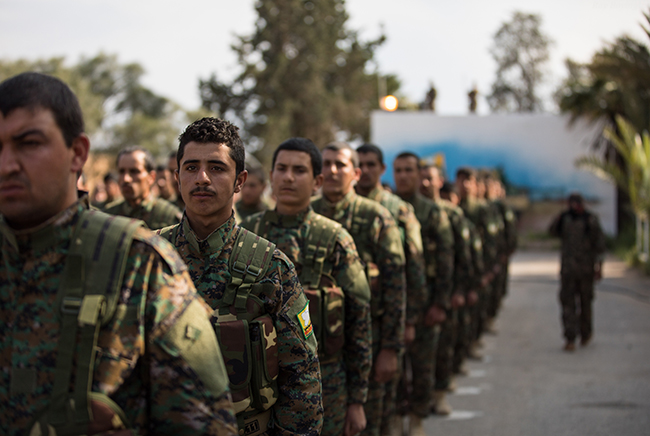
Members of the Syrian Democratic Forces stand in formation during a victory announcement ceremony over the defeat of the Islamic State's so-called physical caliphate on Mar. 23, 2019, at Omar Academy in Deir ez-Zor, Syria. Army photo by SSgt. Ray Boyington.
US forces began to withdraw from northeast Syria following a surprise White House announcement late Oct. 6 that American troops would leave the area, clearing the way for what the Trump administration called a “long-planned” Turkish incursion.
After an Oct. 6 call between President Donald Trump and Turkish President Recep Tayyip Erdogan, the White House said the US will “no longer be in the immediate area” of northern Syria as Turkey moves forward with a military operation targeting Kurdish fighters whom the US has backed.
“Removal of the 50 to 100 US soldiers from the safety zone where the Turks may incur is not the beginning of a formal pullout of Syria,” a senior administration official said in an Oct. 7 call with reporters. Those troops will be moved elsewhere in the country, the official said.
Pentagon spokesman Jonathan Hoffman said Oct. 7 that despite US troops leaving the area, it does not endorse a Turkish operation in northern Syria. Defense Secretary Mark Esper and Chairman of the Joint Chiefs of Staff Gen. Mark Milley have told Turkish military leaders that unilateral action would be risky, Hoffman said.
“We will work with our other NATO allies and coalition partners to reiterate to Turkey that the possible destabilizing consequences of potential actions to Turkey, the region, and beyond,” Hoffman said in the statement.
In an effort to limit a possible Turkish incursion, the US Combined Air Operations Center at Al Udeid AB, Qatar, removed Turkey from the air tasking order—the central plan of air operations in the region—and from intelligence, surveillance, and reconnaissance feeds in the airspace around northeast Syria and beyond, according to the Defense Department.
Erdogan has long foreshadowed a Turkish invasion of Syria to push back Kurdish fighters, who the US supported in its fight against the Islamic State, but who Turkey sees as aligned with the Kurdistan Workers’ Party that has rebelled against Ankara for decades.
US-backed Syrian Democratic Forces, largely composed of Kurdish fighters, were responsible for reclaiming major swaths of ground from the Islamic State inside Syria, such as liberating Raqqa and the terror group’s final holdout of Baghouz. Freeing the latter prompted the US to declare in March that the physical IS caliphate was defeated.
Trump, in a series of tweets on Oct. 7, said the decision is to get out of “ridiculous endless wars” but left the door open for a return to military operations.
“As I have stated strongly before, and just to reiterate, if Turkey does anything that I, in my great and unmatched wisdom, consider to be off limits, I will totally destroy and obliterate the Economy of Turkey (I’ve done before!),” Trump tweeted, adding that it is time for others in the region to protect their own territory.
Lawmakers swiftly pushed back against the notion of withdrawal. Senate Majority Leader Mitch McConnell (R-Ky.) said doing so would only benefit Russia and Iran, and would increase the chance that the IS would return. He called on Trump to keep the coalition together and “prevent significant conflict” between Turkey and Syrian Kurdish forces.
Sen. Lindsey Graham (R-S.C.) said on Twitter that he and Sen. Chris Van Hollen (D-Md.) would introduce a measure to sanction Turkey if it invades Syria, and to call for its suspension from NATO if Turkey attacks Kurdish forces.
The Syrian Democratic Forces, in a series of statements, said it had removed its military fortifications in the area “based on our confidence in the US efforts” under an existing security agreement. If Turkey attacks SDF personnel, the SDF argues it would “reverse the successful effort” to defeat the IS by limiting its ability to guard prisons with insurgent fighters and camps that hold the terror group’s families.
The US and Turkey agreed on the security pact in August to allow for a safe zone in northeast Syria, prompting the SDF to pull weapons further away from the Turkey-Syria border and allowing Syrian refugees in Turkey to return home, according to US Central Command. Since then, US and Turkish forces have repeatedly patrolled the region and observed destroyed Kurdish fortifications.
The White House’s recent announcement came after multiple defense officials reiterated that the US and Turkey maintain a close military relationship, pointing to the joint patrols. Esper, speaking to reporters on Oct. 5, said he was focused on helping the security agreement and its joint patrols function. That is the “best path forward for all of us,” he said.
US European Command boss USAF Gen. Tod Wolters on Oct. 3 also said the US and Turkish military relationship is “as strong as it has been in the past.” The two nations have sparred this year over Turkey’s acquisition of the Russian-made S-400 air defense system, which the US says a country that owns the F-35 fighter jet cannot use.
“There’s still lots of consultations ongoing, and we expect this relationship to continue into the future, and we’ll continue to improve with each and every subsequent patrol,” Wolters said of Turkey and the US.